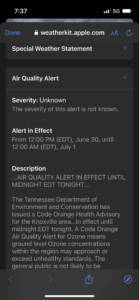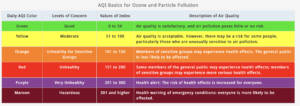When I woke up this morning for my run the sky was hazy and my Weather app warned me about poor air quality. I opened my email and had several messages from the athletes I coach asking for schedule changes due to high AQI (air quality index) in their towns. All this made me wonder—is it okay to run in bad air quality?
Currently, the smoke from the wildfires in Canada is engulfing parts of the US like New York and Chicago. We have poor air quality in Tennessee but not as bad as those north of us.

This is the second time this summer, runners in the U.S. have not been able to run in bad air quality. Thankfully, the quality of air is supposed to improve in the coming days. But there is no guarantee it won’t happen again. In fact, running in poor air quality is a grim reality runners must deal with these days.
Exploring Exercise in Bad Air Quality
Related: The Benefits for Running in Heat
Unlike running in heat, humidity, and at altitude where the conditions make it challenging, but you are awarded with a stronger cardiovascular system—running in bad air or smoke has zero benefits. In fact, running in poor air quality may even punish you with cardiovascular disease.
I connected with exercise physiologist and 2:25 marathoner Todd Buckingham and Dr. Samantha Stuek from the Hospital for Special Surgery for insights, and looked at the research to help guide you on if or when it is ok to run in bad air quality.
Related: How to Make Running in Humidity Feel Easier
In this article, I will answer:
- What AQI is safe for running?
- Is it ok to run in bad air quality? What about running in smoke?
- What happens if you run in poor air quality?
- Symptoms you should stop running in bad air quality
- Who can and should not run in bad air quality
- Plus, tips for running in bad air quality or smoke
So, let’s get going!
What AQI is safe for running?

An AQI of 151-500 is unsafe for running. An AQI of 150-1 is generally safe unless you are sensitive to air pollution. The higher the AQI, the higher the health risks.
So, what is AQI?
AQI stands for Air Quality Index, and it is a measurement the EPA uses for the quality of the air based on the amount of five major pollutants in the area:
- Ozone
- Particulate matter
- Nitrogen dioxide
- Sulfur dioxide
- Carbon monoxide
The AQI is divided into six color-based categories with different levels of concern. The EPA guidelines for AQI and exercise are as follows:
- Good (0-50) (green): Air quality is good. It’s safe to exercise outdoors.
- Moderate (51-100) (yellow): Air quality is acceptable. Raised levels of pollutants may affect your breathing if you exercise outdoors, especially if you have asthma or allergies. Unusually sensitive people should consider reducing prolonged or heavy exertion.
- Unhealthy for Sensitive Groups (101-150) (orange): Pollutant concentrations may affect sensitive groups, especially those with lung or heart problems. Consider indoor exercise or limit prolonged or heavy outdoor activity to reduce exposure to pollution.
- Unhealthy (151-200) (red): Pollutant concentrations can cause health problems for everyone. DO NOT exercise outdoors.
- Very Unhealthy/Hazardous (201-500) (purple and maroon): Air quality is bad enough to warrant health alerts. Stay indoors with windows closed or leave the area until air quality improves.
Related: How to Run with Asthma
Is it ok to run in bad air quality?

If the air quality has an AQI of 50-150, you can run outside if you take precautions. If the AQI is more than 200, do not run outside. Find a treadmill.
- AQI Safe for Running for healthy people:
- 150 and below
- AQI Unsafe for Running:
- 150 and above
Buckingham explains that when we run, we breathe in more pollutants which can be harmful to your health:
“When you run you increase your breathing rate from about 10-15 breaths per minute to 40-60 breaths per minute and increases the amount of air coming into your lungs nearly tenfold. This introduces more pollutants and particulate matter into your lungs, regardless of the air quality. Furthermore, when we run, we typically transition from nasal breathing to mouth breathing. Nasal breathing filters the air whereas mouth breathing does not.”
Inhaling particulate matter (a mixture of solid particles and liquid droplets) greater than 2.5 micrometers in diameter (PM2.5) can negatively impact your health, he adds.
Fine particles less than 2.5 micrometers are what cause the haze we see from wildfires. These microscopic particles get into your eyes, nose, and respiratory system, and may even end up in your bloodstream.
Related: 9 Tips to Avoid Getting Sick
Risks of exercising in poor air quality include:
- Irritated airway and sore throat
- sneezing and coughing,
- an impaired immune system,
- increased inflammation in the body
- heart rhythm abnormalities and heart disease
- and decreased maximal exercise performance.
Related: 6 Treadmill Workouts for Runners
Can I run in smoke?

Running in smoke may cause burning eyes, runny nose, and bronchitis. Regular exposure to running in smoke can even cause chronic lung and heart disease and even death.
“Smoke created by wildfires is carried by wind and weather patterns and contains air toxins that can be dangerous to the human body. So, while you may not be living close to an active wildfire it can still be significantly affecting your local air quality,” explains Dr. Stuek.
Running in the smoke will be more damaging to the airways than running in poor air quality due to pollen or other allergens, says Buckingham. You might be more sneezy and sniffly with pollen in the air but it won’t cause the same damage to the airways as running in the smoke.
Symptoms can progress to bronchitis, pneumonia, and if you have a previous diagnosis of asthma or COPD exacerbation, says Dr. Stuek. If you experience shortness of breath or chest pain, please call 911 and be seen right away.
Related: Tips for Running with Allergies
Does air quality affect stamina?
Yes, air quality does affect stamina because your body isn’t able to get sufficient oxygen to your working muscles. A 2019 study of marathoners running in polluted air confirms this.
What’s more, running for several days in poor air quality can have a cumulative effect and lower a runner’s threshold for symptoms. This means you’ll become more sensitive to running in bad.
Who should not run in smoke or polluted air?
The following people should not even think about running outside if the AQI is 100 or above:
- People with existing heart and lung issues
- Young children under 12
- Master’s runners
- Diabetics and people who are overweight
- And pregnant or nursing women
Related: Your Guide to Running while Pregnant
Who can run in bad air?
Healthy people between the ages of 12 and 70 with no underlying health conditions can run outside if the AQI is between 50 and 150.
9 Tips for Running in Poor Air Quality
So, you’re like me and you wake up and check the AQI on your weather app and see the air quality is above 100, borderline ok—what do you do? Here are steps for staying safe while running in poor air quality:
Check air quality.

Check the AQI at Airnow.gov on your weather app to know what the risks are. If the AQI is above 100, proceed with the below precautions. If it is above 150, don’t run outside.
Adjust your run.
Run for shorter time (like an hour of less) at a lower intensity to minimize the amount of particulate matter you’re breathing in. Consider running by RPE (rate of perceived exertion) or effort.
Related: How to Run by RPE
Leave the kids home.
If you had planned on doing a stroller run or having your kids bike alongside you as you run, don’t. The health risks of bad air are worse for children under 12. Instead, find childcare and leave them at home.
Wear a mask.
Consider kicking it pandemic old school and wear an N95 mask to filter the air you’re breathing in. Buffs and scarves do not protect you from particulate matter.
Breathe through your nose.
If you can, try nasal breathing or nose breathing during your runs. This will help filter the air and also push you to keep your pace easy.
Related: Benefits of an Easy Running Pace
Hit the trails.

Opt to run in shady areas on dirt paths away from asphalt, traffic, city pollution, and heat.
Go early.
The earlier you run before the summer heat, the better the air quality may be. Again, check with your local health department or weather applications that track the air quality index as it shifts with changes in the wind and can be different on different days, advises Dr. Stuek.
Listen to your body.
If you start coughing, have a sore throat or have difficulty breathing, call it a day and head home.
Find a treadmill.
If the air quality is bad, I highly suggest you find a treadmill. You can buy one used, get a day pass to a gym, or use a friend’s. A treadmill is a wonderful resource for runners (bad air or not) and an effective way to build mental strength and consistency.
Related: Treadmill Tips for Busy Moms
Don’t let poor air quality keep you from exercising. The negative impact of inactivity can be worse than that of bad air. Instead, adjust and be flexible. That’s something all runners (especially mother runners) can benefit from!
If you want guidance with your running goals, check out my run coaching services. Also, be sure to check out my free training plans:
- Postpartum Training Plan
- After a Break Training Plan
- 5k Training Plans
- 10k Training Plans
- Half Marathon Training Plans
- Marathon Training Plans
- Strength Training Plan
